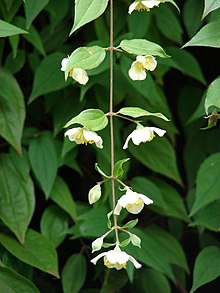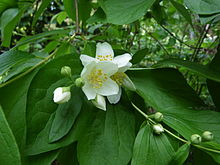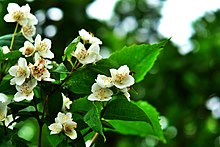Pipe bushes
| Pipe bushes | ||||||||||||
|---|---|---|---|---|---|---|---|---|---|---|---|---|

False jasmine ( Philadelphus × virginalis ), here as a cultivated horticultural form with double flowers |
||||||||||||
| Systematics | ||||||||||||
|
||||||||||||
| Scientific name | ||||||||||||
| Philadelphus | ||||||||||||
| L. |
The Philadelphus ( Philadelphus ) constitute a genus within the family of hydrangeaceae (Hydrangeaceae) or a separate family of Pfeifenstrauch plants (Philadelphaceae) together with Kirengeshoma . The approximately 70 species are mainly found in North America and East Asia. The best known species in Europe is the common pipe bush ( Philadelphus coronarius ), which, like some other plant species , is also called false jasmine. Some Philadelphus species and their varieties are used as ornamental plants in parks and gardens . The common German name Pfeifenstrauch comes from the fact that the pulp inside the branches can be easily removed so that children can make pipes from it.
description





Vegetative characteristics
Philadelphus species are woody plants, they are almost always independently upright growing, rarely climbing shrubs . There are both deciduous and evergreen species.
The always- against-constantly arranged deciduous leaves are divided into a short petiole and leaf blade. On the simple leaf blade, three or five distinct leaf veins usually go forward from the blade base . The leaf edge can be whole or sawn. There are no stipules .
Generative characteristics
The flowers are rarely single, usually in large numbers in paniculate , racemose or zymose inflorescences that are formed on this year's wood.
In many species, the flowers give off a more or less intense fruity smell, which has earned them the common German name "Falscher Jasmin" and the common English name "mock orange". The hermaphroditic flowers are radial symmetry and usually four-fold, sometimes five-fold with a double flower envelope . The four or rarely five sepals are fused with each other and with the ovary. The four or five petals rarely have turned (contorte) vernation on as in the related Kirengeshoma and are white or cream, sometimes at the base and slightly reddish one. The 13-90 stamens sit in a tight circle on the circular ring-shaped flower axis covering the entire ovary surrounds. The flat stamens are often a little overgrown or free at their base. The yellow or whitish anthers ( anthers ) are egg-shaped or elongated, rarely spherical. Usually four or rarely five carpels are fused to form a subordinate or semi-subordinate, usually four or rarely five-chamber ovary. There are many pendulous ovules. The stylus is usually four, rarely three or five lobes.
The capsule fruit opens with four or rarely five valves and contains more than ten seeds per fruit compartment. The rusty brown seeds are spindle-shaped and sometimes tailed.
The basic chromosome number is x = 13.
Locations
The majority of the species grows in bushes or as undergrowth in mixed forests on mountain slopes.
Systematics and distribution
The genus Philadelphus belongs to the tribe Philadelpheae in the subfamily Hydrangeoideae within the family of Hydrangeaceae .
The genus Philadelphus was designed by Carl Linnaeus in his work Species Plantarum erected . The scientific generic name Philadelphus can be traced back to the Egyptian king Ptolemaios II . He was nicknamed Philadelphos (from the Greek philein = love and adelphos = brother, sister). A synonym for Philadelphus L. is Syringa Mill. Nom. illegal.
They are found from western and southeastern North America (about nine species) via Mexico to Central America and in Eurasia from the southeastern Mediterranean area via the Caucasus to East Asia and the Himalayas . Main areas of distribution are the New World and East Asia.



The genus Philadelphus contains 25 to about 70 species (selection):
- Philadelphus affinis Schltdl. : It was first described from Mexico.
- Philadelphus austromexicanus S.Y.Hu
- Philadelphus bifidus (CLHitchc.) SYHu
- Philadelphus brachybotrys (Koehne) Koehne : It thrives at altitudes of 200 to 400 meters in the Chinese provinces of Jiangsu , Jiangxi and Zhejiang and perhaps also in Fujian.
- Philadelphus calvescens (Rehder) SMHwang : It thrives at altitudes of 2,400 to 3,500 meters in the Chinese provinces of Sichuan and Yunnan .
- Philadelphus caudatus S.M. Hwang : It thrives at altitudes of around 1900 meters in Yunnan.
- European pipe bush ( Philadelphus coronarius L. , Syn .: Philadelphus caucasicus Koehne ): It is widespread in the northern hemisphere in North America and Eurasia.
- Philadelphus coulteri S. Watson
- Philadelphus dasycalyx (Rehder) SYHu : It thrives at altitudes of 700 to 2500 meters in the Chinese provinces of Gansu , Henan , Shaanxi and Shanxi .
- Philadelphus delavayi L. Henry : It occurs in three varieties in Myanmar , Tibet , Sichuan and Yunnan.
- Philadelphus glabripetalus S.Y.Hu
- Philadelphus henryi Koehne : The two varieties thrive at altitudes of 1,300 to 2,500 meters in the Chinese provinces of Guizhou and Yunnan.
- Philadelphus hirsutus Nutt. (Syn .: Philadelphus hirsutus var. Intermedius S.Y.Hu , Philadelphus hirsutus var. Nanus S.Y.Hu , Philadelphus sharpianus S.Y.Hu , Philadelphus sharpianus var. Parviflorus S.Y.Hu ): It thrives at altitudes of 100 to 800 meters in the USA.
- Philadelphus hitchcockianus S.Y.Hu
- Later pipe bush ( Philadelphus incanus Koehne ): It occurs in three varieties in the Chinese provinces of Henan, Hubei , Hunan , Shaanxi, Shanxi, Sichuan and perhaps also in Fujian and Hebei.
- Philadelphus inodorus L. (syn .: Philadelphus floridus Beadle , Philadelphus floridus var. Faxonii Rehder , Philadelphus gloriosus Beadle , Philadelphus GRANDIFLORUS Willd. , Philadelphus inodorus var. Carolinus S.Y.Hu , Philadelphus inodorus var. GRANDIFLORUS (Willd.) A.Gray , Philadelphus inodorus var. laxus (Schrader ex DC.) SYHu , Philadelphus inodorus var. strigosus Beadle , Philadelphus strigosus Beadle (Rydb.) ): It thrives at altitudes from 0 to 1000 meters in North America.
- Philadelphus kansuensis (Rehder) SYHu : It thrives at altitudes of 2400 to 3500 meters in the Chinese provinces of Gansu, Qinghai and Shaanxi.
- Philadelphus karwinskyanus Koehne : It occurs in Mexico .
- Philadelphus kunmingensis S.M. Hwang : The two varieties only thrive in Yunnan at altitudes of 2000 to 2100 meters.
- Philadelphus laxiflorus Rehder : It thrives at altitudes of 800 to 2000 meters in the Chinese provinces of Gansu, Henan, Qinghai and Shaanxi.
- Philadelphus lewisii Pursh (Syn .: Philadelphus californicus Benth. , Philadelphus confusus Piper , Philadelphus cordifolius Lange , Philadelphus gordonianus Lindl. , Philadelphus gordonianus var. Columbianus (Koehne) Rehder , Philadelphus helleri Rydb. , Philadelphus insignis Carriére , Philadelphus lewisii var. Angustifolius ( Rydb.) SYHu , Philadelphus lewisii subsp. californicus (Benth.) Munz , Philadelphus lewisii var. ellipticus S.Y.Hu , Philadelphus lewisii subsp. gordonianus (Lindl.) Munz , Philadelphus lewisii var. gordonianus (Lindl.) Jepson , Philadelphus lewisii var. helleri (Rydb.) SYHu , Philadelphus lewisii var. intermedius (A.Nelson) SYHu , Philadelphus lewisii var. oblongifolius S.Y.Hu , Philadelphus lewisii var. parvifolius Torr. , Philadelphus lewisii var. platyphyllus (Rydb.) AHMoore , Philadelphus oreganus Nuttall ex SYHu , Philadelphus trichothecus S.Y.Hu , Philadelphus zelleri S.Y.Hu ): It thrives at altitudes from 0 to 2500 meters in western Canada ( Alberta , British Columbia ) and the western United States ( Washington , California , Idaho , Montana , Oregon ).
- Philadelphus lushuiensis T.C.Ku & SMHwang : It thrives in Yunnan at altitudes of 2300 to 2400 meters.
- Philadelphus maculatus (CLHitchc.) SYHu
- Philadelphus madrensis Hemsl.
- Philadelphus mearnsii W.H. Evans ex Rydb. (Syn .: Philadelphus hitchcockianus S.Y.Hu , Philadelphus mearnsii subsp. Bifidus C.L. Hitchcock ): It thrives at altitudes from 1300 to 1800, rarely up to 2200 meters in the US states of New Mexico and Texas and in the Mexican state of Coahuila .
- Mexican pipe shrub ( Philadelphus mexicanus Schltdl. ): This evergreen shrub with cream-colored, strongly scented flowers occurs in Mexico .
- Small-leaved pipe shrub ( Philadelphus microphyllus A.Gray ): The five varieties grow as a smaller shrub and are found in the southwestern United States and Mexico.
- Philadelphus myrtoides Bertol.
- Philadelphus oblongifolius S.Y.Hu : It was first described from Mexico.
- Philadelphus occidentalis A. Nelson
- Philadelphus osmanthus S.Y.Hu
- Philadelphus palmeri Rydb.
- Peking whistle bush ( Philadelphus pekinensis Rupr. ): It occurs in Korea and China.
- Philadelphus pringlei S.Y.Hu
- Soft-haired mock orange ( Philadelphus pubescens Loisel. , Syn .: Philadelphus gattingeri S.Y.Hu , Philadelphus intectus Beadle , Philadelphus intectus var. Pubigerus S.Y.Hu , Philadelphus latifolius Schrader , Philadelphus pubescens var. Intectus (Beadle) AHMoore , Philadelphus pubescens var. Verrucosus (Schrader) SYHu , Philadelphus verrucosus Schrader ): It thrives at altitudes from 0 to 1000 meters in North America.
- Philadelphus pueblanus S.Y.Hu : It was first described from Mexico.
- Philadelphus purpurascens (Koehne) Rehder : The three varieties thrive at altitudes of 2200 to 3500 meters in Sichuan and Yunnan.
- Philadelphus reevesianus S.Y.Hu : It occurs in Hebei.
- Philadelphus satsumanus Siebold ex Miq. (Syn .: Philadelphus acuminatus Lange , Philadelphus yokohamae Dippel ): This endemic occurs only on the Japanese island of Honshu .
- Philadelphus schrenkii Rupr. : It occurs in three varieties in southeastern Russia, Korea and China.
- Philadelphus sericanthus Koehne : It occurs in two varieties in China.
- Philadelphus serpyllifolius A.Gray : It thrives at altitudes from 1100 to 1900, rarely up to 2300 meters in Texas and in Coahuila, Mexico.
- Philadelphus subcanus Koehne : The three varieties thrive at altitudes of 500 to 2300 meters in the Chinese provinces of Hubei, Sichuan and Yunnan.
- Manchurian pipe bush ( Philadelphus tenuifolius Rupr. ): It occurs in two varieties in south-eastern Russia, in Korea and in China.
- Philadelphus tetragonus S.M.Hwang : It thrives in mixed forests at altitudes of around 3200 meters only in Sichuan.
- Philadelphus texensis S.Y.Hu : The two varieties occur in Texas and in Coahuila, Mexico.
- Felty pipe bush ( Philadelphus tomentosus Wall. Ex G.Don ): It occurs in India , Kashmir , Nepal , Bhutan , Sikkim and in China.
- Philadelphus tsianschanensis Wang et Li : It thrives in mixed forests at altitudes of 400 to 600 meters in Liaoning .
- Philadelphus zhejiangensis S.M. Hwang : It thrives at altitudes of 700 to 1700 meters in the Chinese provinces of Anhui , Fujian , Jiangsu and Zhejiang .
use
Because of their pretty, fragrant flowers, various species are planted as ornamental shrubs . Most of the plants offered are, however, hybrids , especially between the European pipe bush , the Oregon pipe bush and the small-leaved pipe bush .
proof
literature
- Alan S. Weakley, James Henrickson: Philadelphus Linnaeus. - Same text online as the printed work , In: Flora of North America Editorial Committee: Flora of North America , Volume 12: Magnoliophyta: Vitaceae to Garryaceae , Oxford University Press, New York and Oxford 2016, ISBN 978-0-1906-4372-0 .
- Andreas Roloff , Andreas Bärtels: Flora of the woods. Purpose, properties and use. With a winter key from Bernd Schulz. 3rd, corrected edition. Eugen Ulmer, Stuttgart (Hohenheim) 2008, ISBN 978-3-8001-5614-6 , pp. 447-450.
- Wu Zheng-yi, Peter H. Raven (Ed.): Flora of China . Volume 8: Brassicaceae through Saxifragaceae . Science Press / Missouri Botanical Garden Press, Beijing / St. Louis 2001, ISBN 0-915279-93-2 , pp. 395 (English).
- Göritz, Hermann: Deciduous and coniferous trees for garden and landscape , Deutscher Landwirtschaftsverlag Berlin, 6th edition 1986, ISBN 3-331-00031-0
- Helmut Genaust: Etymological dictionary of botanical plant names. 3rd, completely revised and expanded edition. Nikol, Hamburg 2005, ISBN 3-937872-16-7 , p. 215 (reprint from 1996).
Individual evidence
- ↑ a b c d e f g h i j k l m n o p q r s t u v w x y z aa ab ac ad ae af ag ah Huang Shumei, Hideaki Ohba, Shinobu Akiyama: Philadelphus , p. 395 - Text same online as printed work , In: Wu Zheng-yi, Peter H. Raven, Deyuan Hong (Eds.): Flora of China. Volume 8: Saxifragaceae. Science Press and Missouri Botanical Garden Press, Beijing and St. Louis 2010, ISBN 0-915279-93-2 .
- ↑ a b c d e f g h i j k l m n Alan S. Weakley, James Henrickson: Philadelphus Linnaeus. - Same text online as the printed work , In: Flora of North America Editorial Committee: Flora of North America , Volume 12: Magnoliophyta: Vitaceae to Garryaceae , Oxford University Press, New York and Oxford 2016, ISBN 978-0-1906-4372-0 .
- ↑ a b c d e Philadelphus in the Germplasm Resources Information Network (GRIN), USDA , ARS , National Genetic Resources Program. National Germplasm Resources Laboratory, Beltsville, Maryland.
- ↑ Helmut Genaust: Etymological Dictionary of Botanical Plant Names, pp. 477–478
- ↑ a b c d e f g German name after Roloff et al .: Flora of the woods

